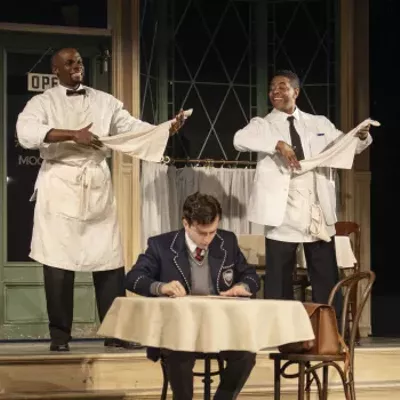The newest of the three plays is Letters to Sala at Invisible Theatre. Arlene Hutton's script is derived from the book Sala's Gift, in which Ann Kirschner tells of the hundreds of letters her mother, Sala, received and hoarded in World War II labor camps. They were valuable enough to Sala for her to keep them at the risk of her life, yet she would later hide them from her American children, whom she wanted to raise untainted by accounts of the Nazi era. (See "Keeping People Alive," Performing Arts, March 15.)
Sala's Gift was fast-tracked to the stage, and Hutton readily admits that the script still needs some work. She's right, but if you think of IT's production as a first public draft, the play shows plenty of potential despite its flaws.
In 1940, 16-year-old Sala Garncarz volunteered to take her sister's place for what she expected to be a six-week stint in a German labor camp. Sala was bright and restless and thought this would be a fine way to see a bit of the world beyond the patch of Poland where she'd been growing up. Those six weeks stretched into five years as Sala was sent from one camp to another, suffering ever-worsening conditions.
It wasn't exactly a prison camp, though; at least early on, Sala was allowed a visit home to her family, and she was sometimes sent to work outside the camp if the facilities didn't have, for instance, the proper sewing equipment. And for the first few years, she was able to correspond voluminously with her family and friends. Or at least they could write to her; many of her own letters were apparently intercepted before they left the camp.
Sala's sister Raizel kept her informed of family affairs. A beau or two in the camps would leave her love notes. Other friends she made in camp would write to her after they'd been transferred. Against the rules, Sala kept these letters squirreled away throughout the war, and during her comfortable later life in America. Saving the correspondence was a way of keeping those people alive.
Playwright Hutton moves the action back and forth between the present, when the elderly Sala reveals the letters to her daughter Ann, and World War II. Jetti Ames plays the older Sala, Rebecca Beren her young counterpart, and all the rest of the roles are taken by merely three other actors. The flashback scenes, all based on the letters or Sala's diary entries, are acted out to greater and lesser degrees. This keeps the action from becoming static, a danger with plays that are essentially epistolary, yet right now, the scenes are breaking apart into little chunks that don't quite fit together into a unified work.
Early in the play, the modern-day scenes are perfunctory, a diversion from the story we really want to follow. Hutton should either expand these scenes--there's plenty of time, as the play runs less than 90 minutes--to make us care more about the elderly Sala and her American family, or she should eliminate this framing device entirely and focus on the young Sala.
There's work to be done in the wartime scenes, too. Some important characters aren't sufficiently fleshed out. A woman named Ala, for example, becomes Sala's protector and mentor in the labor camp, but what's her motivation? Initially, especially as played by the versatile Amy Almquist, Ala seems like a mannish predator rather than a potential benefactor. Is this really what Hutton (and, for that matter, director Susan Claassen) had in mind?
And because the play is based largely on letters to Sala rather than from her, Sala remains a passive figure through much of her own story. We gather from her correspondents that Sala was a strong, fiery figure, but we see little of that displayed onstage, except from what Beren can wordlessly insinuate. Beren does very well with what she's got to work with; the flash in her eyes in the early scenes, her half-smile when she arrives in camp for what she expects to be a short adventure and says, "Everything is strange to me"--these are the few indications we have that Sala herself was full of life.
Why, though, doesn't anybody use contractions, without which so many lines turn stilted? It's almost as off-putting as Tony Curtis showing up in a codpiece and declaiming, "Yonder lies da castle of my faddah."
The acting is a bit variable, but the most consistently fine work comes from two of the youngest performers: Beren, as mentioned, and the vivacious Rachel Lacy as a number of Sala's friends and relatives. Almquist and Ames are, as always, fully reliable. Nate Weisband takes all the male roles, and he's most successful with the more sympathetic characters. As an American GI named Sidney, Weisband makes us see exactly why Sala would eventually marry this kindly man, but when Weisband takes on less desirable figures, like a lounge lizard named Harry, his readings go flat.
Despite these shortcomings, Letters to Sala is worth seeing for the moving story at the center of the fine play this will someday become.
Meanwhile, the sometimes cautious Live Theatre Workshop is going out on a limb with an almost-new play by Tucsonan Toni Press-Coffman. In Holy Spirit on Grand Avenue, three successful and privileged women reunite many years after having been best buddies at the Bronx Catholic girls' school of the play's title. Eventually, the conversation turns to a classmate of theirs who was murdered more than 20 years before, when she was just 8 years old.
That girl, Diana, is a constant presence throughout the play, trying to understand the adult conversation of her former friends, chatting with an apparition of the boy who killed her, and venting her growing bitterness and frustration to the audience.
Press-Coffman is a prolific writer whose work is more widely presented out of town than here at home. The last Press-Coffman play you probably saw was That Slut! in an independent production in 2003. (She also did the most recent Tucson Pastorela update at Borderlands Theater, but that's more of a made-to-order project.)
In Holy Spirit on Grand Avenue, Press-Coffman draws on her own memory of a Catholic classmate being murdered by a neighborhood Jewish boy twice her age--meaning he was only 16. The two had been friends, and nobody quite understood why the boy went to little Diana's apartment one day and stabbed her nearly two dozen times. You won't get a full explanation from this play, either; the author is more interested in showing us how people who know each other don't really understand each other, and how understandings between two people can be inscrutable to the rest of the world.
The three women in the story are successful adults, but they still see each other as they were in elementary school. Barbara is the lively egghead; Celeste is the cynical and rather distant artist; and Stephanie is ... well, she's the one weak character in this script. Oh, she's plenty interesting: Probably one of the few black girls in the Catholic school, Stephanie grew up, married a nice Jewish boy, converted and now works on behalf of the Jewish community center in upscale Westchester County. But Press-Coffman doesn't give Stephanie much to do besides bringing various characters together; that's important, but it would be nice if she were more than a catalyst.
Little Diana looks on as her old chums reunite, becoming increasingly bitter that everybody else has grown up, but she never had that chance. She chats and bickers with her friend-killer, Bobby, who has lost both his parents and spends day after day saying kaddish for his late mother. He has faithfully followed the commandment to honor his father and mother, but what has he gotten from it? What if he were to break commandments? Would being bad have as few repercussions as being good?
Meanwhile, Celeste is stuck in a bad marriage and believes that her husband is about to take their kids away from her. Only when facing the prospect of losing her own children does she manage to remember lost Diana, but Diana has little sympathy for Celeste. Being taken away by your father isn't at all comparable to being murdered. As Diana watches Celeste fall apart, all she can muster is a mocking "boo-hoo-hoo."
Press-Coffman explores some big ideas, including the question of whether faith--and its lack--can be manifested through deeds, but this is not a self-consciously intellectual play full of stick figures mouthing somebody's philosophy. The characters are fully fleshed out and individualized (if underused, in Stephanie's case), and director Glen Coffman (the playwright's husband) keeps all the interactions real.
The cast is uniformly fine. Amy Erbe, Carrie Hill and Suzanne Darrell play the three friends like, well, three cantankerous old friends. Paul Matlock is the sullen Bobby, and David Johnston brings depth to a character who plays an important part in the play's second half. Sixth-grader Molly Howard is outstanding as Diana: inquisitive, petulant and appreciative of past kindnesses, but increasingly resentful that she wasn't allowed to grow up with her classmates.
Rock star Janis Joplin didn't quite grow up, either, although she had about 20 years more opportunity than Diana. Joplin is the subject of Love, Janis, the third offering in Arizona Theatre Company's current RepFest. Be assured that this is not just one of those smarmy jukebox musicals lionizing some popular singer of yore; oh, there's plenty of music here, but this is a serious and effective study of a figure who is very sympathetic, despite her outrageousness and personal failings.
Were Joplin alive today, she might well be just another has-been on the pops-orchestra circuit. But her early death by drug overdose froze Joplin in memory as a performer near her peak, a force of sex and emotional chaos on stage. That was Janis Joplin the rock star; this play also shows us Janis as a lonely young woman trying to maintain fragile ties to her folks back in Texas even as she becomes a rising star in countercultural San Francisco.
She's played by two performers: actress Marisa Ryan (who wasn't even mentioned in the week-old RepFest program I was using) and, on opening night, singer Cathy Richardson (she alternates with Sophia Ramos). Writer-director Randal Myler sometimes has the two appear in the same scene, usually when Janis is being interviewed by a disembodied voice. (The script is adapted from Joplin's interviews and letters home to Texas.) Here, the contrast between the two Janises is most explicit: Ryan is girlish and fairly wholesome in a puckish way, while Richardson looks pale, gaunt and a little strung-out--Janis as celebrity-junkie-slut.
As a singer, Richardson does one hell of a Janis Joplin impersonation--her Act 1 finale is emotionally devastating--and that seems to be what most of the opening-night audience had come for. I've never seen so many 60-year-old heads bobbing together except in a Parkinson's clinic. But the real heart of the show is Ryan, who comes off as an intelligent, unruly, likable and lost kid from Port Arthur. Too bad that Myler found it necessary to turn Love, Janis into a feel-good show; after the poor girl is dead, and Ryan leaves the stage, Richardson perseveres through three upbeat musical numbers. As the authors of Letters to Sala and Holy Spirit on Grand Avenue understand, sometimes a life is better conveyed through commemoration rather than celebration.







